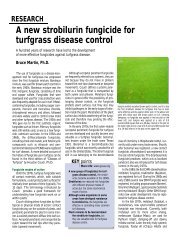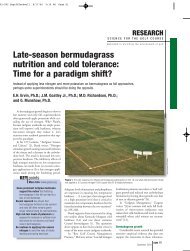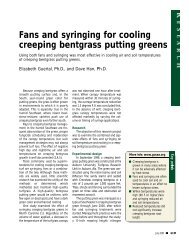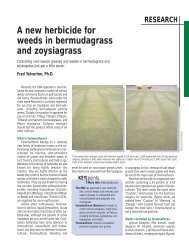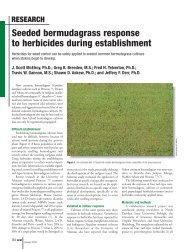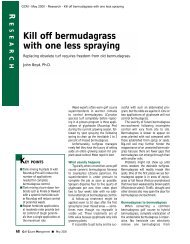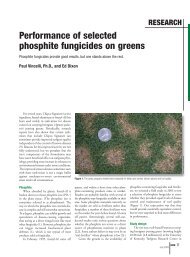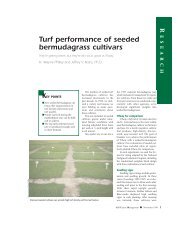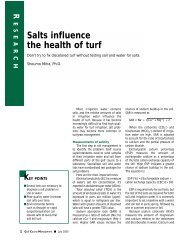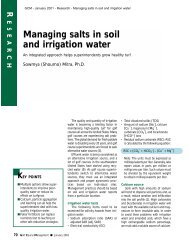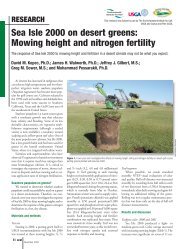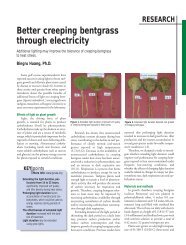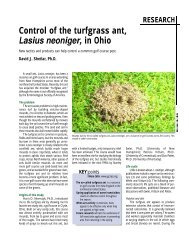Surface organic matter in bermudagrass greens: A primary ... - GCSAA
Surface organic matter in bermudagrass greens: A primary ... - GCSAA
Surface organic matter in bermudagrass greens: A primary ... - GCSAA
Create successful ePaper yourself
Turn your PDF publications into a flip-book with our unique Google optimized e-Paper software.
RESEARCHgram) CEC because little dead <strong>organic</strong> <strong>matter</strong>was present at CEC sites and essentially no claywas found. Thus, some <strong>organic</strong> <strong>matter</strong>enhances CEC status.Thatch or mat?Is the surface zone of high <strong>organic</strong> <strong>matter</strong>thatch or mat? Thatch is a zone of deadand liv<strong>in</strong>g <strong>organic</strong> <strong>matter</strong> without appreciablesand <strong>in</strong>tegrated <strong>in</strong>to it. Sometimes athatch zone created dur<strong>in</strong>g grow-<strong>in</strong> becomesburied and rema<strong>in</strong>s as a thatch layer problem.Mat is an <strong>organic</strong> zone that has considerablesand <strong>in</strong>tegrated with<strong>in</strong> it, with sand as thedom<strong>in</strong>ant matrix.From field observations, it appears that thequantity of sand topdress<strong>in</strong>g sufficient to ma<strong>in</strong>ta<strong>in</strong>a uniform, stable surface with goodputt<strong>in</strong>g speed is often less than the quantity oftopdress<strong>in</strong>g required to create a true mat. Thesurface zone of many <strong>greens</strong> appears to be a“near mat,” but with <strong>in</strong>sufficient sand to negatethe <strong>organic</strong> <strong>matter</strong>. When sand is not ma<strong>in</strong>ta<strong>in</strong>edas the <strong>primary</strong> matrix, the result is considerablesand float<strong>in</strong>g <strong>in</strong> the <strong>organic</strong> <strong>matter</strong>. Inthat case, the <strong>organic</strong> <strong>matter</strong>, not the sand, controlsthe aeration and moisture status.Management practices<strong>Surface</strong> <strong>organic</strong> <strong>matter</strong> accumulation ismanaged by a comb<strong>in</strong>ation of the follow<strong>in</strong>gpractices.Dilution. Dilution of the surface <strong>organic</strong><strong>matter</strong> through aggressive topdress<strong>in</strong>g, especially<strong>in</strong> comb<strong>in</strong>ation with hollow-t<strong>in</strong>e aerationand vent<strong>in</strong>g operations, is the backboneof any successful program. A recent article (5)provides excellent options and guidel<strong>in</strong>es thatare appropriate for <strong>bermudagrass</strong> and creep<strong>in</strong>gbentgrass <strong>greens</strong>. The suggested targetrange for annual topdress<strong>in</strong>g on many sites,40-50 cubic feet/1,000 square feet (121.9-152.4 cubic meters/hectare), is based on historicalrates that were used until a few yearsago when ultralight but more frequentapplications became the norm and resulted<strong>in</strong> less total sand applied.Us<strong>in</strong>g adequate hollow-t<strong>in</strong>e core aerationoperations and vent<strong>in</strong>g operations to ma<strong>in</strong>ta<strong>in</strong>macropores across the surface <strong>organic</strong> <strong>matter</strong>zone at all times is important for ensur<strong>in</strong>goxygen diffusion across the zone to reachunderly<strong>in</strong>g roots. Develop<strong>in</strong>g and ma<strong>in</strong>ta<strong>in</strong><strong>in</strong>gdeeper roots allows less-frequent irrigationso that the surface zone has the opportunityto dry somewhat, which greatly improves oxygenstatus with<strong>in</strong> the zone. If topdress<strong>in</strong>g andFigure 3. Greens with poor air circulation and dra<strong>in</strong>age often exhibit excessive <strong>organic</strong> <strong>matter</strong> <strong>in</strong> the surface layer.Excessive <strong>organic</strong> <strong>matter</strong> <strong>in</strong>duces high moisture and lower oxygen content <strong>in</strong> the root zone, <strong>in</strong>hibit<strong>in</strong>g microbial decompositionof the <strong>organic</strong> <strong>matter</strong>.cultivation operations are <strong>in</strong>sufficient to controlthe surface <strong>organic</strong> <strong>matter</strong> zone quickly,the result will be shallow roots, which requirelight, frequent irrigation and frequent spoonfeed<strong>in</strong>g.This situation fosters even more<strong>organic</strong> <strong>matter</strong> accumulation.<strong>Surface</strong> pH levels. The surface pH shouldbe higher than 5.5 to allow adequate bacterialpopulations for <strong>organic</strong> <strong>matter</strong> decomposition.One practice that has beenrecommended for <strong>bermudagrass</strong> decl<strong>in</strong>e hasbeen the use of acidify<strong>in</strong>g fertilizers. Oneresponse that occurs on soils with at leastsome clay is that at pH below 5.5, more solublemanganese is often observed. However,on sands with CEC from primarily <strong>organic</strong><strong>matter</strong>, this is not the case. Adequate manganeseis important for suppress<strong>in</strong>g take-allpatch (3,4). If the surface pH is below 5.5,the reason for a low pH should be determ<strong>in</strong>ed.Water acidification can cause a lowpH at the surface while also add<strong>in</strong>g appreciablesoluble sulfur. If anaerobic conditionsstart with<strong>in</strong> or below the surface <strong>organic</strong> <strong>matter</strong>zone, the presence of soluble sulfur willgreatly <strong>in</strong>crease the chance for black layer (6).Take-all. On sites with an exist<strong>in</strong>g <strong>organic</strong><strong>matter</strong> problem and a history of take-all, itmay be worthwhile to test not only foliar applicationsof manganese, but also some granularapplications to achieve higher manganese levelswith<strong>in</strong> both the plant and <strong>organic</strong> zone.Secondary stresses. If excessive <strong>organic</strong><strong>matter</strong> stimulates a particular secondarystress, then practices to control the secondarystress will be of immediate concern.Photo courtesy of R.N. CarrowSummaryIn summary, the new ultradwarf <strong>bermudagrass</strong>esused on putt<strong>in</strong>g <strong>greens</strong> have a strongtendency to accumulate <strong>organic</strong> <strong>matter</strong> with<strong>in</strong>the surface zone, and certa<strong>in</strong> stresses are frequentlyobserved on these grasses (decreasedroot<strong>in</strong>g over time, root-rot pathogens, others).The challenge for the super<strong>in</strong>tendent is toidentify the <strong>primary</strong> or underly<strong>in</strong>g stresses andmanage them aggressively.References1. Carrow, R.N. 2004. <strong>Surface</strong> <strong>organic</strong> <strong>matter</strong> <strong>in</strong> bentgrass<strong>greens</strong>. Golf Course Management 72(5):96-101.2. Duncan, R.R., and R.N. Carrow. 2000. Seashorepaspalum: The environmental turfgrass. Wiley,Hoboken, N.J.3. Elliot, M. 2001. Got root rot? Don’t panic. Florida TurfDigest March/April 20-23.4. Heckman, J.R., B.B. Clark and J.A. Murphy. 2003.Optimiz<strong>in</strong>g manganese fertilization for the suppressionof take-all patch disease on creep<strong>in</strong>g bentgrass.Crop Science 43:1395-1398.5. O’Brien, P., and C. Hartwiger. 2003. Aeration andtopdress<strong>in</strong>g for the 21st century. USGA GreenSection Record 41(2):1-7.6. Unruh, J.B., and S. Davis. 2001. Diseases and heatbesiege ultradwarf <strong>bermudagrass</strong>es. Golf CourseManagement 69(4):49-54.Robert N. Carrow, Ph.D. (rcarrow@griff<strong>in</strong>.uga.edu), is aprofessor of turfgrass science and a research scientistat the Georgia Experiment Station, University of Georgia,Griff<strong>in</strong>. Carrow was an <strong>in</strong>structor at <strong>GCSAA</strong> educationsem<strong>in</strong>ars <strong>in</strong> San Diego, and he is one of the subject<strong>matter</strong> experts for <strong>GCSAA</strong>’s onl<strong>in</strong>e W.A.T.E.R. course.May 2004GCM 105



